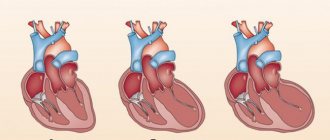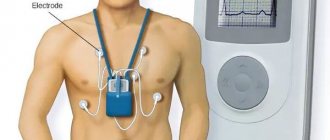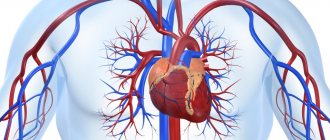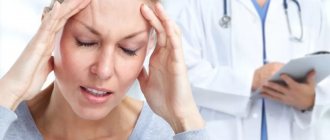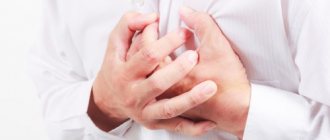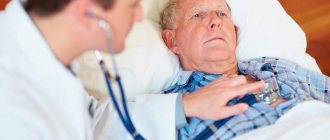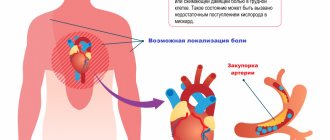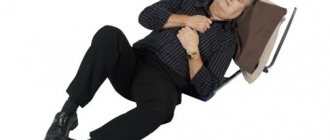First aid for an angina attack
Angina almost always accompanies ischemic heart disease. However, with other cardiovascular diseases (thickening of the heart muscle, anemia), attacks of angina are also recorded. Symptoms primarily include severe chest pain and shortness of breath. And the reasons are oxygen starvation of the heart tissue due to atherosclerotic narrowing of the lumen of the coronary vessels or severe vascular spasm. The trouble is that the disease manifests itself suddenly, so both the patient and his relatives must know what to do during an attack of angina, how to provide first emergency aid. It is worth remembering that this disease is a pre-infarction condition, and therefore requires qualified diagnosis and treatment. Now you can undergo a consultation and a set of preparatory examinations when registering for a course of enhanced external counterpulsation or shock wave therapy of the heart absolutely free of charge!
Promotion
Just until the end of autumn, undergo a free consultation and a set of preparatory examinations* when registering for a course of enhanced external counterpulsation or shock wave therapy of the heart.**
Send a request
* Check the details of the Promotion by phone. **Has contraindications; consultation with a doctor is required.
Enhanced external counterpulsation (EECP) Cardiac shock wave therapy (SWTS)
Hurry up to apply, the promotion period is limited.
Causes of the disease
The main cause of the pathology is atherosclerosis (often in the initial stage). As a rule, patients are smokers and have concomitant diseases such as:
- cholecystitis;
- arterial hypertension;
- allergy;
- ulcer, etc.
With such diseases, an imbalance occurs in the autonomic nervous system and a tendency to vascular spasms.
Seizures can be provoked by:
- emotional stress;
- hypothermia;
- hyperventilation of the lungs.
Signs of an angina attack
Since the vessels supplying blood to the heart are narrowed due to atherosclerotic plaques, only a small physical or emotional stress is enough for the heart muscle to feel a lack of oxygen and nutrients. At this time, lactic acid is produced in the tissues, which causes pain.
If, after you have worked physically or been over-excited, you experience heart pain, know that these are the first signs of illness. As it develops, less and less stress will be required to cause an attack. In severe cases, signs of angina appear when walking at an average pace for a distance of 200 meters or climbing one floor.
Diagnostics
Accurate methods for detecting pathology do not currently exist. The basis for diagnosis is laboratory tests.
They provide information about the content of substances in the blood such as glucose and hemoglobin, cholesterol, AST and ALT, as well as triglycerides. These indicators do not allow making an accurate diagnosis, but provide an opportunity to assess the complete picture of the patient’s health status.
Additionally, electrocardiography is required. Diagnostics, including an ECG, are also not always informative. This is due to the fact that normal results do not negate a positive diagnosis. Load tests are being carried out. They allow you to understand how well the heart muscle can cope with increased rates of work.
The most effective diagnostic methods include:
- Coronary angiography. The examination reveals abnormalities in the arteries that supply nutrition to the heart. Coronary angiography shows the lumens of blood vessels and the presence of plaques in them.
- Holter monitoring. This examination is also effective, as it allows you to assess the condition of the heart.
- Tests under load. Such studies are effective for pathology without stenosis. Tests can only be carried out in specialized institutions. This is due to the fact that they can provoke an attack.
Symptoms of an angina attack
External signs of the disease are similar to the symptoms of vegetative-vascular dystonia, pinched nerve, osteochondrosis, pleurisy, so you should know how an angina attack differs from them.
Often the manifestations are quite individual. In different patients, an attack can last 1-15 minutes. And even pain is perceived in different ways: as sharp, squeezing, aching, radiating to the jaw, shoulder, throat, accompanied by a burning sensation.
Painful sensations occur:
- when walking fast, climbing stairs;
- physical activity (especially after a heavy meal);
- emotional tension, excitement, worries, stress;
- sudden movement from a warm room to a cold one;
- at rest at night.
An attack of angina is accompanied by additional symptoms and signs. If, when pain occurs, your eyes darken, profuse sweat appears, your limbs become cold, you feel that you are about to faint, call a doctor immediately - first emergency aid is necessary! In women, these symptoms include stomach pain with nausea and heartburn, shortness of breath and a feeling of weakness.
Recommendations
To prevent angina attacks you must:
- quit smoking
- control cholesterol levels, if necessary, eat a low-fat diet
- perform a dosed and doctor-selected set of physical exercises
- avoid stress
- lead a healthy lifestyle
A balanced diet, dosed physical activity and regular monitoring by a qualified doctor can save a patient with angina pectoris from heart surgery.
First aid for an angina attack
Has the disease manifested itself for the first time? The most correct decision would be to call an ambulance. If you have an attack of angina, the signs and symptoms of which appear during walking or physical exertion, stop immediately and rest. It is best to take a comfortable position, sitting or lying down, and take nitroglycerin, which is usually used to relieve angina attacks.
If you take nitroglycerin 3 times, and it does not give the usual relief in 20 minutes - the symptoms do not go away, then you are close to a heart attack and require immediate medical help, possibly with transfer to intensive care.
Emergency care for symptoms of an angina attack also includes self-massage - it helps relieve acute pain, tension and an instinctive feeling of fear. Massage the left chest, neck, and back of the head. Pay attention to the knee, shoulder, and wrist joints.
Treatment history
Case No. 1
Kirill, 57 years old. Experienced smoker, hypertensive (“working” pressure 150/95 mmHg). Five years ago, according to the patient, he had problems with his heart and blood pressure, was examined, took prescribed medications for six months, then stopped taking them on his own. During the visit to the clinic, attacks of chest pain appeared during physical activity, which went away when the exercise stopped. At the doctor’s appointment, blood pressure is 170/100 mmHg, rapid pulse is 90 beats per minute. The patient was examined - an increase in the level of “bad” cholesterol was detected, ECG and ultrasound of the heart without signs of ischemia, and ischemia was recorded on the 24-hour ECG monitor at the time of significant physical activity, i.e. there is angina pectoris. The patient was given a treatment regimen for angina pectoris, which resulted in normalization of blood pressure and cholesterol levels within 3 months, and a significant increase in exercise tolerance. With the help of a psychotherapist, the patient decided to quit smoking and took up Nordic walking with a gradual increase in loads under the supervision of a cardiologist. Over the past year, angina attacks have not bothered me. It is recommended to continue taking medications and undergo regular preventive examinations.
Thanks to cooperation with doctors and the desire to feel better, the patient was able to change his lifestyle, prevent complications of the disease and prolong his life for many years.
How to relieve an angina attack at home?
If an attack occurs while you are lying down, you need first aid. First of all, they helped you sit down and lower your legs down. Unbutton your collar, ask them to open a window in the house, apartment, or other room where you are and take nitroglycerin.
If you feel weak, pale, or have cold sweats, measure your blood pressure. If it is reduced, there is no need to take nitroglycerin. In this case, it is better to relieve the attack with aspirin. But the effect of validol is causing controversy in the world of medicine: doctors are increasingly inclined to believe that it is ineffective.
To provide effective first aid during an angina attack, always keep baralgin, sedalgin, and analgin in your first aid kit. If you have symptoms such as headaches, take one of these medications. For elevated heart rates, anaprillin is recommended.
Rules for taking nitroglycerin
As part of first aid for an angina attack, you can use both tablets (to relieve an attack outside the home) and drops. The medicine is dropped onto a piece of sugar, which is placed under the tongue and wait until it dissolves. Check the dosage with your doctor, but remember: you cannot take more than 3 tablets (drops) in 15 minutes.
You may feel dizzy, because the effect of the medicine is to dilate blood vessels and reduce pressure. Therefore, before taking, take a comfortable position, sitting or lying down.
After discharge
Basically, drug treatment does not change after discharge from the hospital. The patient must take most medications for life. You can read more about medication regimens and dosages here. Some drugs are not indicated for long-term use by the patient, for example, anticoagulants, except when they are necessary for the treatment of concomitant diseases.
If the patient has undergone PCI with stenting, he must take 2 antiplatelet drugs (Acetylsalicylic acid and Clopidogrel) for at least 1 year. Next, he needs to switch to a constant intake of 1 medication - if he does not have a gastric ulcer or duodenal ulcer, then Acetylsalicylic acid, if he does, then Clopidogrel.
To prevent the development of ulcers, I recommend that my patients add drugs that reduce the formation of hydrochloric acid in the stomach - Omeprazole, Pantoprazole.
Why is it important to see a doctor?
Even if there was only one attack, this is a sufficient reason to undergo diagnostics in a qualified cardiology clinic. Angina pectoris can lead to myocardial infarction and even death. Only an experienced cardiologist will promptly identify the problem and prescribe treatment that will help you avoid the fatal risk.
You will receive the full range of qualified cardiological services for the diagnosis, treatment and prevention of cardiovascular diseases at the CBCP Center for Circulatory Pathology, equipped with expert-class European equipment.
Angiotensin-converting enzyme inhibitors (ACEIs)
Angiotensin-converting enzyme inhibitors (ACEIs)
–
for angina pectoris,
they are prescribed to prevent the development of heart failure.
Therefore, drug doses are usually lower than for the treatment of hypertension. If after a MI you develop symptoms of heart failure or doctors identify impaired LV function, adding an ACE inhibitor to your therapy will significantly reduce the risk of death and the likelihood of a recurrent MI. The effect of drugs such as ramipril, trandolapril, zofenopril, enalapril has been proven. If these drugs are poorly tolerated, it is possible to replace them with angiotensin receptor antagonists. ACE inhibitors can be prescribed for angina pectoris without a history of heart attack
- their ability to slow the progression of atherosclerosis has been proven. The effect of the drugs ramipril and perindopril has been proven.

